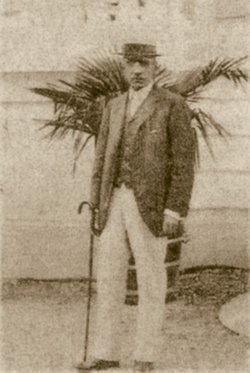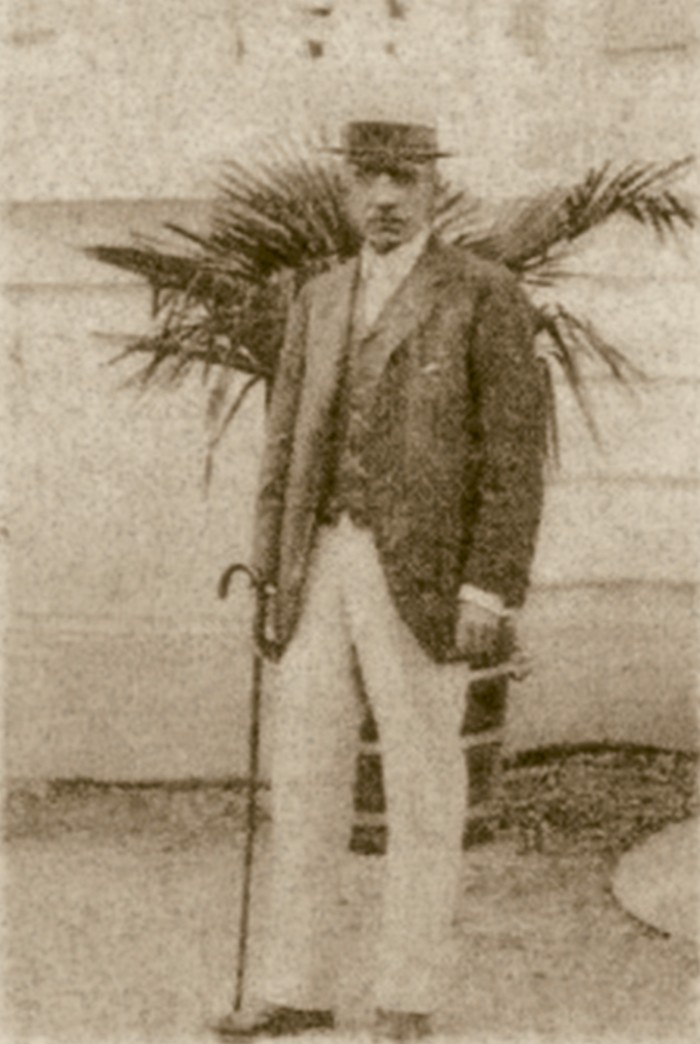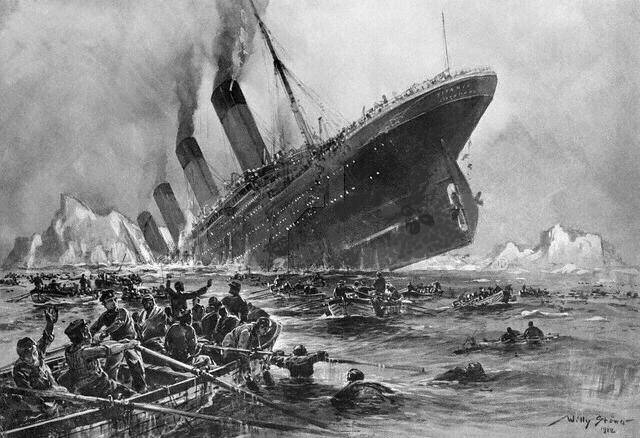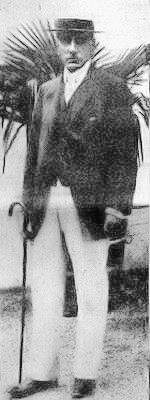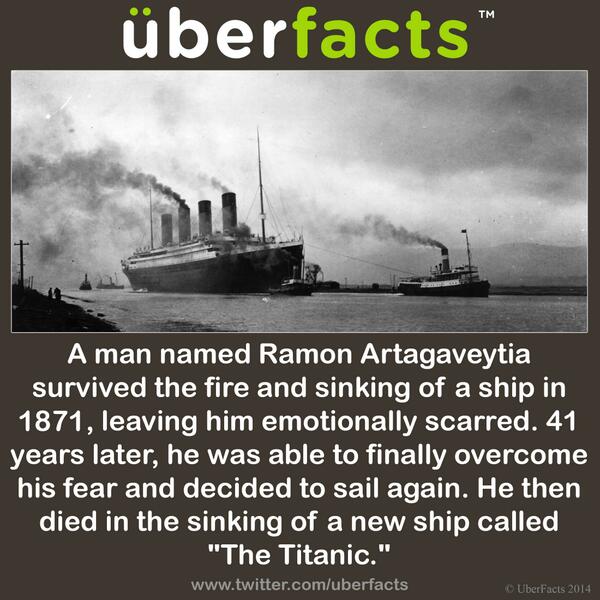He was born on 14 July 1840 in Montevideo, Uruguay. He was the son of Ramon Fermin Artagaveytia and Maria Josefa Marcisa Gomez y Calvo.
Ramon was born to a family steeped in the history of the sea, according to family legend, just before his death, his grandfather gave Ramon's father an oar, dedicated with the words:
"Knowing how to use it, you will never be hungry. Your ancestors have always survived thanks to the sea. This is your destiny. Follow it!"
On 24 December 1871 Ramon survived the fire and sinking of the ship America, close to the shore of Punta Espinillo, Uruguay. Newspapers reported that the America had been racing another ship into Montevideo harbour and high boiler pressures had led to a fire. There were 114 first class, 20 second class and 30 "popular" class. Only 65 passengers survived. Ramon escaped by jumping into the sea and swimming for his life. Many of the passengers were horribly burned, and the episode left Ramon emotionally scarred.
In 1905 Ramon took over a farm in Guaminí, Argentina.
In 1912, Mr Artagaveytia was still living in Argentina but travelled to Europe to visit his nephew who was the head of the Uruguayan Consulate in Berlin. He was heading to the United States for a visit before returning to Argentina.
On February the 9th, 1912, two months before sailing on the Titanic, Ramon wrote to his cousin Enrique Artagaveytia, showing his hope for a successful crossing: "At last I will be able to travel and, above all, I will be able to sleep calm. The sinking of the America was terrible!... Nightmares keep tormenting me. Even in the most quiet trips, I wake up in the middle of the night with terrible nightmares and always hearing the same fateful word: Fire! Fire! Fire!...I have even gotten to the point where I find myself standing in the deck with my lifebelt on..."
In the same letter he expressed his faith in the 'new' system of communication: the wireless telegraph:
"You can't imagine, Enrique, the security the telegraph gives. When the America sank, right in front of Montevideo, nobody answered to the lights asking for help. The ones that saw us from the ship Villa del Salto, did not answer to our light signals. Now, with a telephone on board, that won't happen again. We can communicate instantly with the whole world."
He boarded the Titanic in Cherbourg (ticket number PC 17609, £49 10s 1d) on April 10, 1912, his cabin number remains a mystery as it was never designated on the stateroom assignment list found in the pocket of steward Herbert Cave whose body was later recovered and little is known about Mr Artagaveytia during the voyage.
On 11 April he wrote to his friend Adolfo:
April 11 1912
I closed my eyes and went onboard in this huge ship. One of the carriers took my suitcase, and brought it to third floor. We went to the dining room. saloon C. My cabin is very comfortable. It is heated by electricity. It is on during the night because it is very cold. I met a Mexican diplomate, and a Mr Amingo de Diaz.
April 12 1912 (?)
I went through all the corridors to see all the rooms. Some of the furniture was made of tree. The green chairs were very nice. Now I can see Ireland, and now I am finished writing this letter.
On the night of the sinking, Artagaveytia was observed on deck with two fellow Uruguayan passengers, Mr Francisco M. Carrau and his nephew, Jose Pedro Carrau. This was related by second class passenger (and survivor) Julian Padro y Manent who later said that the three men laughed at his taking the situation seriously. When he announced that he was leaving the ship, Artagaveytia and the Carrau jokingly advised him that it was foolish for him to enter a lifeboat and that he would only catch a cold from being on the open sea in a lifeboat. The accuracy of the above account must be doubted when compared with the very different version of the attitudes and confidence of the Carrau brothers from the memoirs of first-class passenger Elmer Zebley Taylor. Although Mr Taylor does not mention Mr Artagaveytia by name in his account, the description of the Carrau brothers is in direct contradiction from Mr Padro y Manent's version:
'About halfway up the flight (on the way up to the boat deck), there were two gentlemen, one on either side, leaning against the balustrade and, from outward appearance, looked more dead than alive. We [Taylor and his wife Juliet ], had been introduced to these two fine looking men by a mutual friend on the platform in Waterloo Station. They were from Buenos Aires, Argentina. They could not speak English and we could not speak Spanish. As we casually met day by day, we would all speak our native language, smile and pass along, none of us understanding what the other one said. At this meeting, we repeated the usual salutations, shook hands and assured them there was no danger, smiled and proceeded on our way, to carry the fear they exhibited on their faces for the remainder of my life. How terrifying it must have been to those who did not have faith in the wonderful engineering skill displayed in building this massive unsinkable steamer...'
Mr Taylor, who later escaped the Titanic with his wife, in lifeboat 5 , clearly states that the Carraus were not joking about the situation and were quite alarmed - quite the opposite of what Mr Padro y Manent said.
Mr Artagaveytia and the Carraus were lost in the sinking. About a weekfollowing the disaster, Mr Artagaveytia's body was pulled from the NorthAtlantic by the MacKay-Bennett, the recovery vessel chartered bythe White Star Line to search the scene of the wreck for victims. His entrywas logged in:
His body was forwarded to New York and from there was shipped to Montevideo, Uruguay under the auspices of the Uruguayan Consul in New York, Alfred Metz Green. He was buried in the Cemeterio Central, in Montevideo on 18 June 1912.
https://www.encyclopedia-titanica.org/titanic-victim/ramon-artagaveytia.html
He was born on 14 July 1840 in Montevideo, Uruguay. He was the son of Ramon Fermin Artagaveytia and Maria Josefa Marcisa Gomez y Calvo.
Ramon was born to a family steeped in the history of the sea, according to family legend, just before his death, his grandfather gave Ramon's father an oar, dedicated with the words:
"Knowing how to use it, you will never be hungry. Your ancestors have always survived thanks to the sea. This is your destiny. Follow it!"
On 24 December 1871 Ramon survived the fire and sinking of the ship America, close to the shore of Punta Espinillo, Uruguay. Newspapers reported that the America had been racing another ship into Montevideo harbour and high boiler pressures had led to a fire. There were 114 first class, 20 second class and 30 "popular" class. Only 65 passengers survived. Ramon escaped by jumping into the sea and swimming for his life. Many of the passengers were horribly burned, and the episode left Ramon emotionally scarred.
In 1905 Ramon took over a farm in Guaminí, Argentina.
In 1912, Mr Artagaveytia was still living in Argentina but travelled to Europe to visit his nephew who was the head of the Uruguayan Consulate in Berlin. He was heading to the United States for a visit before returning to Argentina.
On February the 9th, 1912, two months before sailing on the Titanic, Ramon wrote to his cousin Enrique Artagaveytia, showing his hope for a successful crossing: "At last I will be able to travel and, above all, I will be able to sleep calm. The sinking of the America was terrible!... Nightmares keep tormenting me. Even in the most quiet trips, I wake up in the middle of the night with terrible nightmares and always hearing the same fateful word: Fire! Fire! Fire!...I have even gotten to the point where I find myself standing in the deck with my lifebelt on..."
In the same letter he expressed his faith in the 'new' system of communication: the wireless telegraph:
"You can't imagine, Enrique, the security the telegraph gives. When the America sank, right in front of Montevideo, nobody answered to the lights asking for help. The ones that saw us from the ship Villa del Salto, did not answer to our light signals. Now, with a telephone on board, that won't happen again. We can communicate instantly with the whole world."
He boarded the Titanic in Cherbourg (ticket number PC 17609, £49 10s 1d) on April 10, 1912, his cabin number remains a mystery as it was never designated on the stateroom assignment list found in the pocket of steward Herbert Cave whose body was later recovered and little is known about Mr Artagaveytia during the voyage.
On 11 April he wrote to his friend Adolfo:
April 11 1912
I closed my eyes and went onboard in this huge ship. One of the carriers took my suitcase, and brought it to third floor. We went to the dining room. saloon C. My cabin is very comfortable. It is heated by electricity. It is on during the night because it is very cold. I met a Mexican diplomate, and a Mr Amingo de Diaz.
April 12 1912 (?)
I went through all the corridors to see all the rooms. Some of the furniture was made of tree. The green chairs were very nice. Now I can see Ireland, and now I am finished writing this letter.
On the night of the sinking, Artagaveytia was observed on deck with two fellow Uruguayan passengers, Mr Francisco M. Carrau and his nephew, Jose Pedro Carrau. This was related by second class passenger (and survivor) Julian Padro y Manent who later said that the three men laughed at his taking the situation seriously. When he announced that he was leaving the ship, Artagaveytia and the Carrau jokingly advised him that it was foolish for him to enter a lifeboat and that he would only catch a cold from being on the open sea in a lifeboat. The accuracy of the above account must be doubted when compared with the very different version of the attitudes and confidence of the Carrau brothers from the memoirs of first-class passenger Elmer Zebley Taylor. Although Mr Taylor does not mention Mr Artagaveytia by name in his account, the description of the Carrau brothers is in direct contradiction from Mr Padro y Manent's version:
'About halfway up the flight (on the way up to the boat deck), there were two gentlemen, one on either side, leaning against the balustrade and, from outward appearance, looked more dead than alive. We [Taylor and his wife Juliet ], had been introduced to these two fine looking men by a mutual friend on the platform in Waterloo Station. They were from Buenos Aires, Argentina. They could not speak English and we could not speak Spanish. As we casually met day by day, we would all speak our native language, smile and pass along, none of us understanding what the other one said. At this meeting, we repeated the usual salutations, shook hands and assured them there was no danger, smiled and proceeded on our way, to carry the fear they exhibited on their faces for the remainder of my life. How terrifying it must have been to those who did not have faith in the wonderful engineering skill displayed in building this massive unsinkable steamer...'
Mr Taylor, who later escaped the Titanic with his wife, in lifeboat 5 , clearly states that the Carraus were not joking about the situation and were quite alarmed - quite the opposite of what Mr Padro y Manent said.
Mr Artagaveytia and the Carraus were lost in the sinking. About a weekfollowing the disaster, Mr Artagaveytia's body was pulled from the NorthAtlantic by the MacKay-Bennett, the recovery vessel chartered bythe White Star Line to search the scene of the wreck for victims. His entrywas logged in:
His body was forwarded to New York and from there was shipped to Montevideo, Uruguay under the auspices of the Uruguayan Consul in New York, Alfred Metz Green. He was buried in the Cemeterio Central, in Montevideo on 18 June 1912.
https://www.encyclopedia-titanica.org/titanic-victim/ramon-artagaveytia.html
Sponsored by Ancestry
Advertisement
Records on Ancestry
Sponsored by Ancestry
Advertisement
